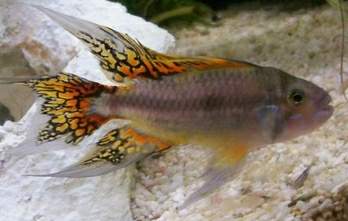
Common name: Cockatoo Dwarf Cichlid, Crested Dwarf Cichlid
Scientific name: Apistogramma Cacatuoides
Average Adult Fish Size: 3 inches / 9 cm
Place of Origin: South America, western Amazon basin: Widely distributed in
clearwater and whitewater tributaries of the Rio Ucayali and Amazon in
western Brazil, Peru and Colombia. Inhabits still waters (lagoons, lakes and
ponds) and slow-moving forest streams having a substrate of leaf
litter.
Typical Tank setup: Bogwood, roots and leaf litter replicate their natural home, however they do well with the addition of plants if preferred. Dim lighting suits them best. Prefers a pH of 6.5 and soft water, though the limits above are acceptable.
Recommended Minimum Aquarium Capacity: 25 gallon / 60 litre
Compatibility: Due to its small size the Cockatoo Cichlid can be housed in a community with smaller fish such as Tetras. Can be aggressive to other Cichlids and males of its own species. Keep a ratio of 1 male : 2 female. Aggressive when spawning – even to the second female in a trio so provide good cover.
Temperature: 75 – 81 Deg. F / 24 – 27 Deg. C
Water chemistry: pH 6.0
Feeding: A varied diet should be given to ensure good health and colour, a base of flake and cichlid pellets supplemented with twice weekly treats of live/frozen bloodworm and brine shrimp etc. Wild caught specimens usually refuse flake initially.
Sexing: Females are easily identified by more subtle colouration, smaller dorsal ray extensions and a general smaller size. Dorsal rays are usually black and red, will display bright yellow spawning colours.
Breeding: Cockatoo Cichlids will pair for breeding and harem breeding is also possible. Cave spawners so provide plenty of hide-aways for the females.
Additional Information: A beautiful dwarf cichlid, and one admirably suited to those unfamiliar with the genus, as it is hardy and easy to spawn. There are blue, yellow and red colour forms occurring naturally in the wild, and several more-intense colour varieties
have been developed from these through selective breeding.
Like all species in the genus, they do not appreciate bright overhead light. A well-planted tank with floating plants makes a good environment, with caves manufactured from rockwork or clay flowerpots. Although one of the hardiest of Apistogramma species, this one still requires good stable water conditions or its colours may pale. Regular weekly partial water changes of 50% of the tank volume are recommended by many writers as essential to keep the fish in good health and condition.
They prefer the Bottom to Middle regions of a tank.


Related Posts
Croaking Gourami – Trichopsis vittatus
Paradise Fish – Macropodus opercularis
Schubert’s Barb – Barbus Semifasciolatus